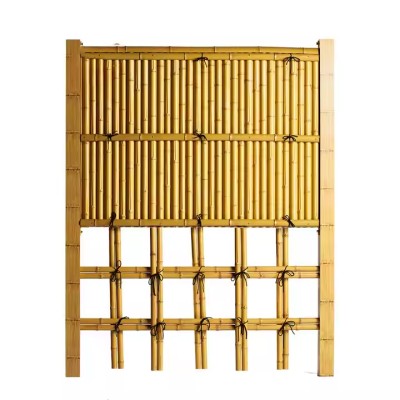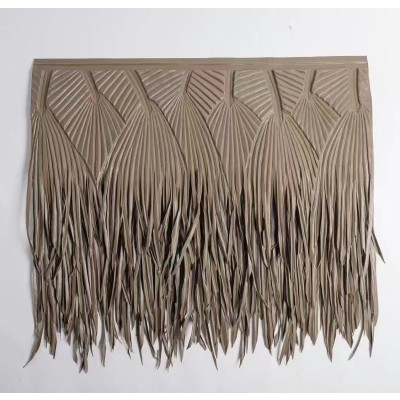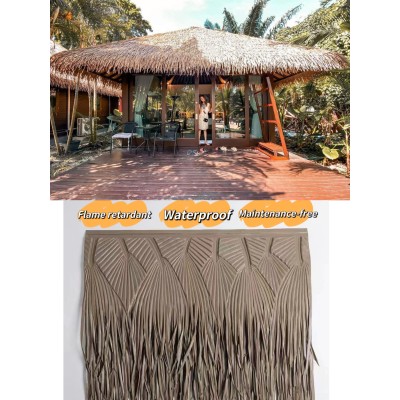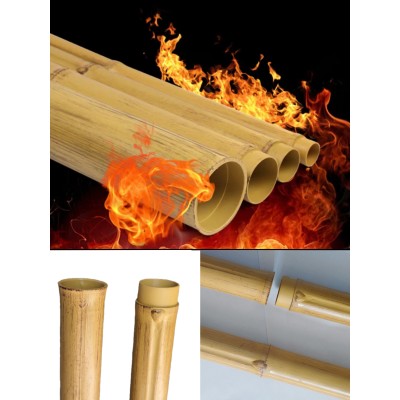Supplier Environmentally friendly Maldives Seaside Resort Artificial thatched shed sunshade thatched roof Synthetic thatched roof
Supplier Environmentally friendly Maldives Seaside Resort Artificial thatched shed sunshade thatched roof Synthetic thatched roof Product advantage
High degree of imitation: the appearance and texture are similar to natural thatch, which can create a strong tropical seaside atmosphere and add a natural and primitive atmosphere to the resort.
Strong durability: with good weather resistance, UV resistance and corrosion resistance, not easy to fade, weathering, decay, long service life, can withstand the harsh climatic conditions of the seaside, such as strong wind, heavy rain, sun and so on.
Good fire performance: many products have flame retardant characteristics, and the fire rating can reach the new national standard B2, that is, self-extinguishing from the fire, effectively reducing the risk of fire and improving the safety of the resort.
Good waterproof performance: After special treatment, it can effectively prevent rainwater penetration, avoid roof leakage and internal structure moisture.
Low maintenance cost: Compared with natural thatch, it hardly needs regular replacement or repair, and only needs regular cleaning to maintain a good appearance, saving manpower and material costs.
Environmentally friendly and recyclable: It is usually made of environmentally friendly materials, does not contain harmful substances, is pollution-free to the environment, and can be recycled after the end of its service life, in line with the concept of environmental protection.
Easy installation: The modular design is used, and the installation process is simple and fast, which can reduce the installation cost and time
Application case
Some seaside resorts in the Maldives, such as Vilamendhoo Island Resort, feature similar artificial thatch roofs with wig-like thatch that complements the surrounding natural environment, providing visitors with a back-to-nature stay experience.
Seaside resorts using artificial thatch shed need to pay attention to the following aspects:
Preliminary planning and design
Site selection and layout: The thatched shed should be set up in an area with high terrain and good drainage, and avoid setting up in a place that is prone to water accumulation or affected by sea tide. At the same time, it is necessary to reasonably plan the layout of the thatched shed, considering the coordination with the surrounding environment, to ensure that it does not affect the overall landscape of the resort and the flow of tourists' activities.
Building design code: Design according to local building codes and safety standards to ensure the structural stability of the thatched shed, such as reasonable determination of the number, spacing and depth of the pillars, as well as the slope and overhang length of the roof, so that it can withstand the common coastal wind, rain and other bad weather.
Material selection and quality control
Material characteristics: Choose artificial thatch material with good weather resistance, UV resistance, fire resistance and water resistance. To ensure that the quality of the material is qualified, no odor, no toxicity, in line with environmental requirements, to avoid adverse effects on tourists and the environment.
Quality testing: When purchasing materials, suppliers are required to provide product quality testing reports and related certifications, such as fire rating certification, environmental protection certification, etc. Conduct strict sampling inspection of the incoming materials to check whether the material, color, length and density of the thatch meet the requirements.
Installation and construction process
Professional construction team: hire experienced professional construction team for installation, construction personnel should be familiar with the installation process and skills of artificial thatch, in strict accordance with construction drawings and specifications operation, to ensure the quality of installation.
Construction safety: In the construction process, it is necessary to take safety protection measures, such as wearing safety hats, safety belts, etc., to prevent construction personnel from falling, slipping and other accidents. At the same time, attention should be paid to the safety of electricity consumption at the construction site to avoid safety hazards such as fire caused by electrical failures.
Windproof measures: When installing thatch sheds, effective windproof measures should be taken, such as strengthening the connection between the roof and the pillar, and using windproof ropes or fixtures to fix the thatch sheds to ensure their stability in strong wind weather.
Use and maintenance management
Daily inspection: arrange special personnel to check the thatch shed regularly, check whether the thatch is loose, falling off, damaged, etc., whether the pillar and structure are stable, and repair or deal with the problem in time.
Cleaning and maintenance: Clean the thatch shed regularly, remove dust, debris and stains on the thatch, and keep its appearance clean and tidy. According to the characteristics and use of the material, timely maintenance, such as painting protective paint, supplementary fire retardant, etc.
Visitor management: Set up obvious safety warning signs in the thatched shed to inform tourists of precautions, such as no smoking, no open fire in the thatched shed, etc., to guide tourists to use and care for the thatched shed correctly.
Emergency plan: Formulate emergency plans for the thatched hut, such as in the event of extreme weather such as strong typhoons and heavy rains, timely evacuation of tourists, take necessary protective measures to ensure the safety of tourists and thatched hut.



